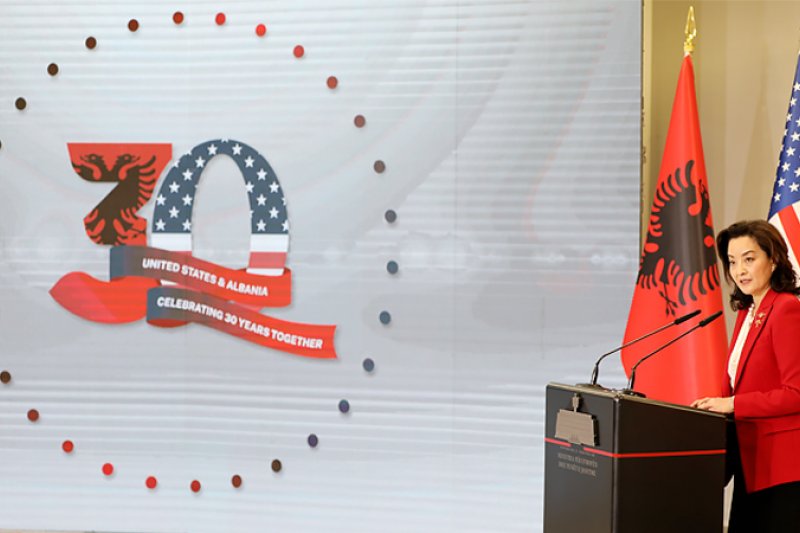What Happened in D.C. on March 15, 1991
It has been written a lot on the relationship between Albania and the United States, and the March 15, 1991 remains one of the highlights - the date when the diplomatic relations between the two countries were reestablished. A ‘reconstruction’ of the events that led to that historical date was published in a special edition of Albanian Daily News on March 15, 2011. It commemorated the 20th anniversary of that milestone.
But this March 15, 2021, which marks the 30th anniversary of that landmark in the complexity of the history of the bilateral relations between the two countries, brings back to my memory some details of that unforgettable day when the Memorandum of Understanding was signed by the then Foreign Minister of Albania, Muhamet Kapllani and the then Assistant Secretary of State for European and Canadian Affairs, Raymond G.H. Seitz in the State Department, sealing the reestablishment of the diplomatic relations between the two countries after a break of 52 years. It happened that I was Councilor to Albania’s UN Mission in New York and became part of the negotiating team with the US side in April 1990.
But turning to the ‘great day’ some moments of that March 15, 1991 are unforgettable with an agenda, which was one of the busiest that I have ever experienced in my humble career.
Foreign Minister Kapllani arrived late in Washington on the evening of March 14. None of us slept that night and that needs no comment. We were ahead of a historic day. The agenda started at 9 o'clock in the morning, a meeting in the US Congress where a group of congressmen was waiting for us. The atmosphere of the reception and the conversation was warm and friendly, which relaxed us. The US Congressmen wanted to know about the situation in Albania, but, however, it was easy to guess that they seemed to be well informed, including the ongoing fierce election campaign in March 1991. One of them asked directly the former minister: What will you do if the Democratic Party wins in the next elections when you can no longer be Minister of Foreign Affairs? A little meditation and his answer was, as far as I remember, that he would teach English at the University of Tirana.
We arrived at the State Department half an hour before the formal ceremony which was fixed at 11 a.m. A protocol officer took me to the ceremony hall to show some details of the protocol procedures during the signing event. The Treaty Hall at the State Department was the venue for the ceremony which symbolically was a gesture to show the importance that the US diplomacy paid to the signing of the MoU.
Assistant Secretary of State for European and Canadian Affairs Seitz and Foreign Minister Kapllani spoke before the Memorandum was signed. And then champagne - it was a unique festive occasion for both parties. This was also shown by the meaningful fact that besides us as representatives of the state there were Albanian-Americans of all political persuasions, prominent scholars and patriots among whom the prominent figure of the old Albanian Diaspora, the late, Antoni Athanas, representatives of legalists, National Front, as well as two representatives of the Democratic Party, which would come to power in 1992, were present in the Hall. The DP would take the power with a US embassy opened in October 1991, with relations also established with Russia, the UK and Israel among others.
The signing ceremony was followed, according to the agenda, with an official luncheon that started in a ‘cold’ atmosphere but got warmer along the course. Then meetings in some main departments covering economy, trade and finances of the US administration followed.
I will never forget what one of the deputy secretaries said in one of the meetings: It has been 200 years since we have established the democratic system in the US, but again we see things that need to be developed and we always do this…The Albanian people will also need a long way to go. As a matter of fact, even now the ‘trip’ goes on in the frame of the endeavor to establish ‘true democracy’ in the country!
On March 16 we continued the 'celebrations’ by organizing a reception at the Albanian UN Mission in New York, and among others it was remarkable the presence of many American diplomats of the US Mission to the UN like never before; they became the first official visitors to the headquarters of the Albanian UN representation in New York.
Unlike when the signing of the MoU was dragged, official Tirana hastened to open formally the Albanian Embassy in the US after the signing of the Memorandum. Diplomats Sazan Bejo and Arben Teta were appointed as the first embassy diplomatic representatives, who were initially stationed at the Mission in New York until they settled in the Washington residence.
The US Embassy in Tirana was opened on October 1, 1991 with Christopher Hill as Chargé d’Affaires ad interim and later succeeded by US Ambassador William Edwin Ryerson, who presented his credentials to the Government of Albania on December 21, 1991.
Every anniversary of the Albanian-American ‘renaissance’ never fades in historical value as an event; on the contrary, the more time passes the symbolic value of that Memorandum grows as a document which brings back the natural ties between Washington and Tirana. I would like to highlight an event of that day, namely March 15, 1991, which I consider interesting to show as it explains the efforts made since then by some to come out as 'victorious' for the restoration of Albania's ties with the US. After the signing of the Memorandum and the ceremony, I was told that the late Deputy Foreign Minister, Sokrat Plaka, had called from Tirana. He asked us to send him immediately a press release on what happened in Washington because the opposition Democratic Party propaganda was loudly ‘advertising’ that its leaders, namely Mr. Sali Berisha, who together with the late Gramoz Pashko, were present at the ceremony invited by the State Department without the knowledge of the Albanian Mission, had allegedly signed the MoU.
The first round of Albanian- US negotiations started by the end of March 1990 in one of the meeting rooms of the UN Security Council which continued with the second meeting in the State Department. The following contacts revealed that the US side was ready to open as soon as possible the respective diplomatic missions. But there was not that attitude in Tirana at that time.
I take this opportunity to quote Bashkim Pitarka, former Permanent Representative of Albania to the UN in Washington and chief negotiator for the restoration of Albanian-American relations regarding the postponement of the date of the signing ceremony of the Memorandum to 15 March 1991. According to him, elements of the hard line in the communist leadership of that time pressed for maintaining the ‘equidistance’ in the relations with the then two superpowers, the US and the Soviet Union and consequently they insisted that after the start of the process for the normalization of the relations with the latter the procedures for the signing of the MoU with the US could go on.
Under such circumstances the disappointed Americans responded in the same way by saying to wait for ‘better days’ decided by them. So, after many months of delay March 15, 1991 was agreed when Albania was passing through great historical changes under a technical government headed by Ylli Bufi and the first pluralist elections to happen on March 31.
Well, here we are after 30 years, but no one can claim for decorations or praise for that historical event; everyone did the duty in the position they were at that time for achieving that day despite the efforts of those who tried to hinder the normal flow, which became unstoppable moving towards where this relationship is now between the Albanian and American nations. It is the case to mention that various US politicians have repeated from time to time that the relations of the US with the Albanian people are not conditioned by any politician, ideology or political party. Rather they are valued as the bond between the two people of the two countries.














